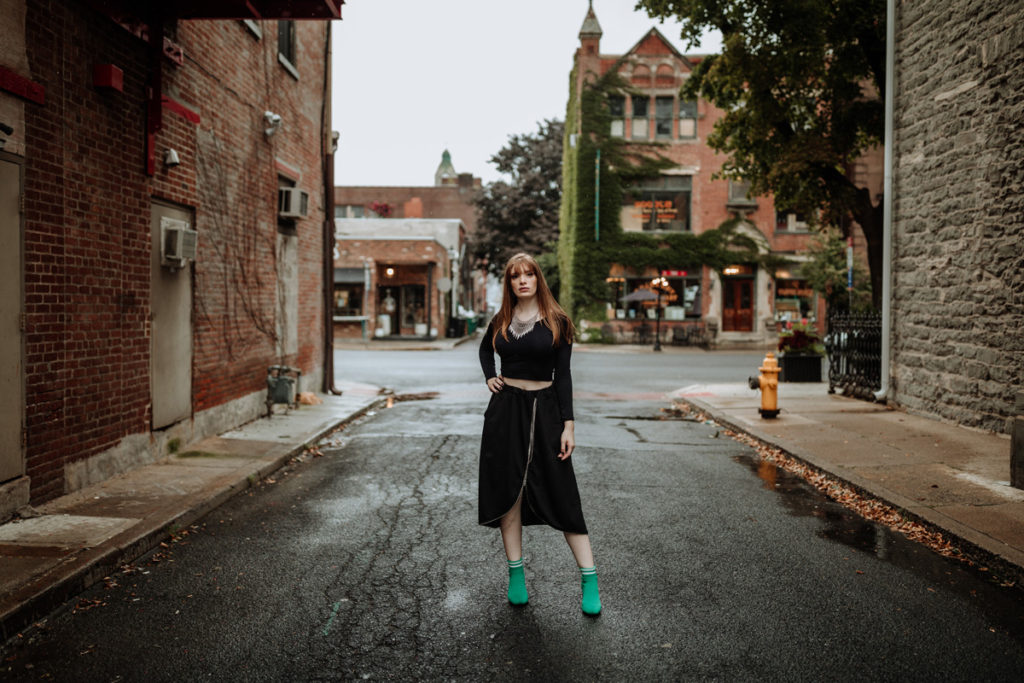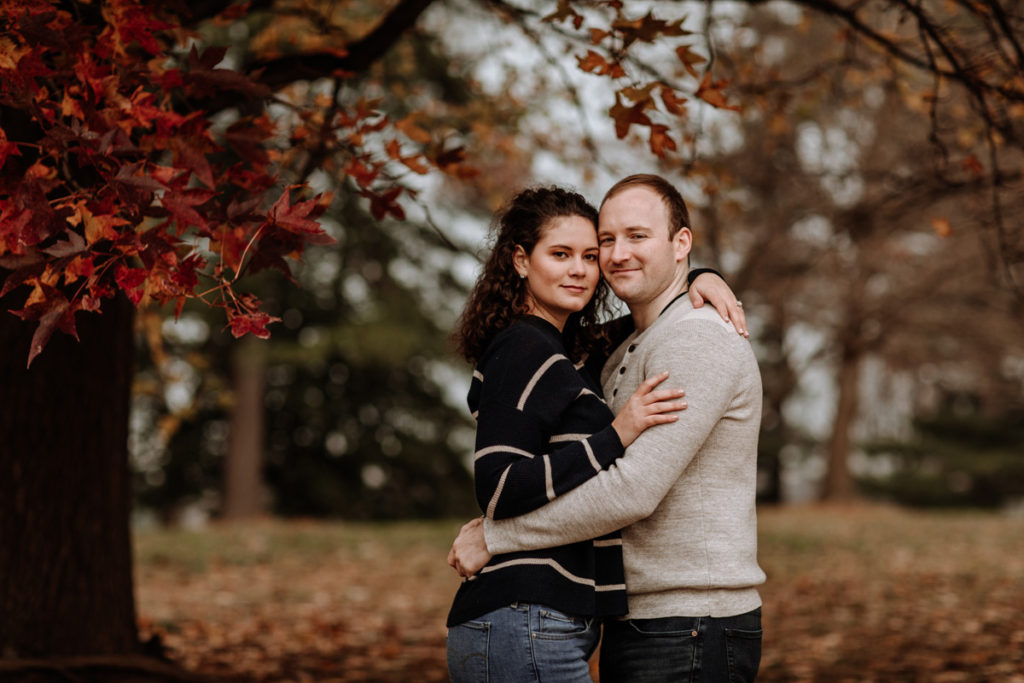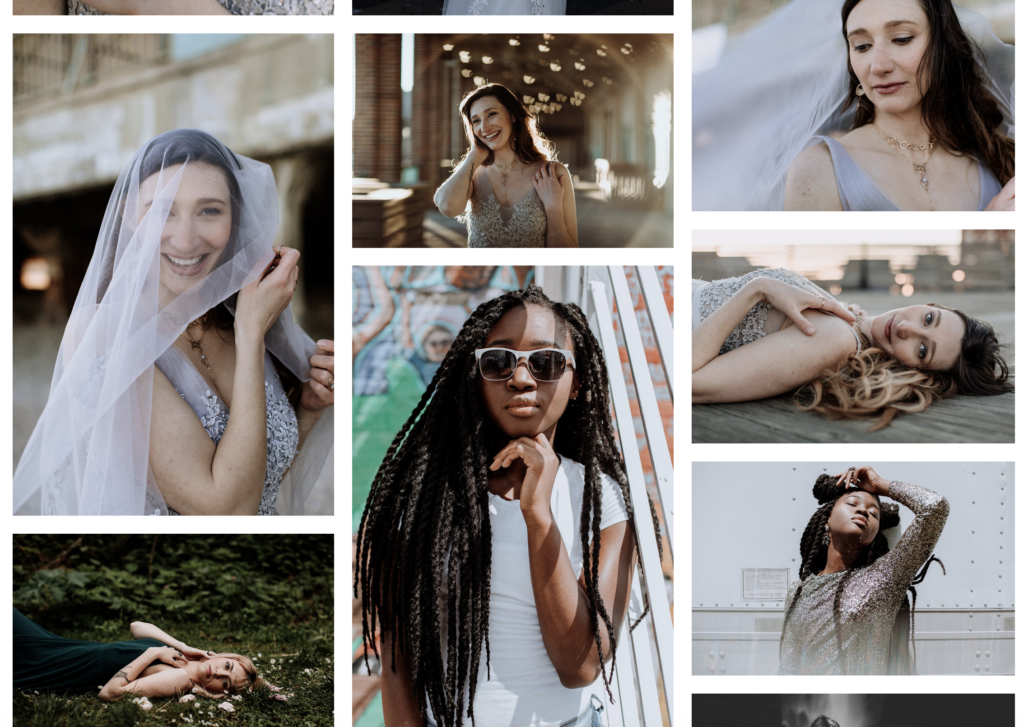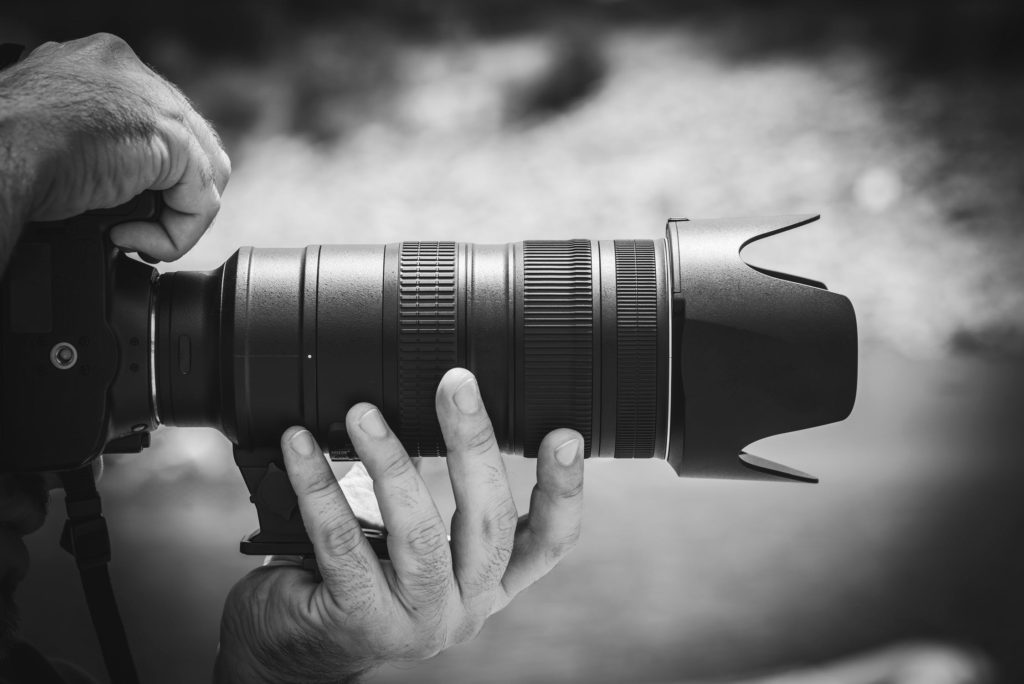Last Updated: February 14th, 2020
Portrait photography has been almost necessary since the dawn of cameras. Once people started seeing that they could capture a picture of some thing in front of them, it became readily apparent that taking pictures of people (and our animal friends) would make for some of the best photo subjects.
Today, portraits are used for a wide range of things. Families get portraits taken to hang on the wall of their homes. Newly married couples have wedding portraits done to document their big day. Professionals have studio portraits taken so they can throw them up on social media like LinkedIn and on company websites. Heck – even newborn babies are getting in on the action as their parents have baby pictures commissioned.
As you can see, as long as there are people around, the world is always going to want good portraits taken.
In this post, we’ll walk you through the steps required to become a portrait photographer. This comes through our hands on experience making this a reality for our own lives – you can do it too!
10 Steps to Become a Portrait Photographer

Step #1: Educate Yourself on the Art of Portrait Photography
Every photographer rises from humble beginnings.
Whether you were turned on to photography through your upbringing, or just decided to explore it as something you thought would be cool – photography is definitely a great hobby and can be turned into a career for sure.
The necessity of education will really depend on your skill level working with a camera (and with living subjects – people and animals!).
We got into photography in high school, and have been attached at the hip (to it and each other) ever since. While we have managed our own photography business for several years now, we continue to educate ourselves to new ideas and photographic processes. It’s amazing because we hit a level where people want to pay us to take portraits of them, yet we’re still finding things to challenge us.
Some of this education just comes from natural exploration and practice. With so many technical skills and good equipment, often we just need to apply the things we already know to new environments and with different goals in mind. The results are usually very good for us – though from time to time, not so much 😊
Outside of the “practice makes perfect” approach, education can come in many different forms including:
- Reading portrait photography books
- Watching videos on portrait photography (YouTube is great for this!)
- Take an online portrait photography course
- Find a portrait photography mentor
- Go to school for photography
In our world, we never went a formal route for photography. We do have college degrees – but in unrelated fields. If you want to read more, check out our About Us page and get a crash course by reading through our How To Start a Career in Photography – Advice From a Pro & Action Plan to Make It Happen article.
When we aren’t actually hands on with our cameras, we’re soaking up the crazy amounts of information available these days. There are a million free resources (just like this article!), and paid options like books and online classes that often provide the most comprehensive and valuable information. It’s practically every day we are reading a new post, watching a new YouTube video, or engaging with a good book – all these things help us to hone our craft.
Really – this educational background is the foundation for any great career in portrait photography. Get it right, and you will be able to take AMAZING images.
Step #2: Learn What Types of Career Opportunities Exist for Portrait Photographers
“Portrait photography” is sometimes difficult to talk about because it is both simple (you take pictures of people/animals) and complex (what is the purpose of the photos?).
As you try to figure out how to make portrait photography a career, there are really only 2 routes you will take – regardless of your niche or specialty. These are:
- Work for an Established Portrait Studio
- Create Your Own Portrait Studio
For the next few moments, we’re going to talk about what both of these options look like, give you some pros and cons, and talk about our experience deciding for our lives.
1). Work for an Established Portrait Studio
It’s easy to understand why working for a portrait studio could be a good solution for some people. All you really need to do is bring photography skills and people skills to the table, the business owners will handle the rest like making sure you’re paid.
The most appealing part of this type of career path in portrait photography is just that – you go to work, take pictures, and go home. There isn’t this huge commitment that being a business owner brings with it.
It is a double edged sword, though, as most often these types of positions are lower paying and reliant on the performance of the business – which you ultimately don’t have much control over.
For us, we could see this route as being preferable if you are just looking for part time work (ie: stay at home mom caring for kids and wanting a good side gig) or want to use it as a stepping stone to building your portfolio and growing in your career.
2). Create Your Own Portrait Studio
Now, having your own portrait studio is entirely different. It can be a little scary, as this is where things become much less about just mastering photography but learning how to run a business.
Interestingly enough, most portrait photographers actually have their own studios. Honestly, it just makes the most sense as it will give you the most control. There is creative freedom that won’t necessarily be found working for someone else’s business.
The benefits can’t be understated, either. We started our own photography business with the benefits in mind like being able to work flexible hours, being able to take time off whenever we needed, and having a larger say in our lives.
Of course, though, it’s not for everyone. While the great things are great, there are many challenges to becoming an established portrait photographer. It takes time to build the reputation, it takes time to make enough money to support yourself. The “business side” of things can also be boring, tiring, [insert undesirable description here].
We went down this road ourselves for many reasons. It’s higher paying (when done right), it gives that flexibility we mentioned, and it’s ours. We treat our photo business like it’s our baby, and sometimes that means long nights staying up. But – it’s so darn cute and great to have, especially now that it’s past the potty training stage. Weird analogy, we know.
Step #3: Work With Established Portrait Photographers
While we showed that one route you can go in making portrait photography a career path is to work for established studios, this step is about finding work with established photographers.
It’s a subtle difference, but a significant one because it can apply to ANY aspiring portrait photographer.
We always recommend 100% of the time that if you are considering pursuing a career in photography to meet some photographers who are already in the game. Meet them, assist them, provide second shooting services, etc. – just get exposed to how things work, and what it feels like to be in the industry.
The wedding photography side of our business began very much like this. We made connections with local photographers (and some around the world!). We met with them over coffee and ended up helping them out by assisting and second shooting weddings they had booked already.
All of this exposure helped us to identify that, yes, we wanted to pursue this type of career for ourselves.
If it turns out that portrait photography isn’t something you want to be in for the long haul, this gives you an opportunity to get your feet wet and make that determination. Of course, it also means that if you like it – you will become OBSESSED with making it a reality!!
Step #4: Define Your Ideal Audience – Who Do You Want to Photograph?
 Portrait photography is for everyone.
Portrait photography is for everyone.
Basically – if it lives and breathes, there is likely going to be someone out there who wants a photo of it. The two main portrait categories you’ll find are “People” and “Animals” – but each of these break down in so many ways. Here’s a few ideas:
People:
- Headshots for professional use
- School portraits – senior’s portraits are especially popular these days
- Wedding portraits
- Couples/engagement portraits
- Anniversary portraits
- Family photos
- Newborn and maternity portraits
- Portraits for birthdays, holidays, etc.
Animals:
- Cat and dog portraits
- Exotic animal portraits
- Pet portraits for holidays – you see this A LOT around Christmas
With so many portrait subjects and occasions out there (we can’t even list them all!), it’s important to identify a few that really appeal to you.
Sure, like any job you may end up taking on work just to have work, but you should always make it a goal to take portraits that are fulfilling for you as a creative.
In our world, the top of our list is taking portraits for couples. This normally comes out in the form of an engagement session and a wedding, but sometimes couples get photos just because or to celebrate an anniversary. We don’t necessarily rule out shoots in other areas, but the main audience we are looking to attract through our branding and portfolio are couples. Having this sort of mentality allows you to be more focused, and attract clients who want you because of your special set of skills.
Step #5: Get Formal Education in Photography
We’ve been out of college for about 7 years now (that thought alone is terrifying and causes an existential crisis). While you probably wouldn’t find us back in one seated behind a desk, there is value there to extract when you are just learning about photography.
When we talk about a “formal education” – college is definitely one route. But, you can get formally educated in other ways. The “formal” part of it is just meaning that you have some sort of structure to how you are learning things.
Here are 3 ways to achieve the formal education bit yourself:
Shadowing other portrait photographers
We already mentioned working with other portrait photographers – but this can be handled in a fast-and-loose kind of way, or in a more formal one.
The way we like to think of it is more in tune with what someone going to school to be a teacher would go through. Normally, the student will find a teacher (or multiple teachers) to shadow for some period of time. The student ends up with a lot of hands on experience in the field thanks to going through the motions of basically being a teacher (without the high level of skills, academic credentials, etc.).
An aspiring portrait photographer can do the same. Heck – they probably should do the same.
You don’t have to be enrolled in a college class to shadow someone – just begin by reaching out to portrait photographers in your area and see if they’d allow you to observe and participate in their work. You could do this for a day, a week, a month – however long you feel necessary to get your bearings straight.
Online and Self-Paced Photography Courses
Sometimes, it’s easiest just to educate ourselves. We’ve gone through a bunch of online photography courses just because we could. While we won’t roll out of bed at 6AM to get to a college desk, doing something like this is a much better solution.
The best part about online photography courses is they are not just limited to a standard curriculum. So many talented and expert photographers are putting together courses of their own, and teaching about concepts that might even go overlooked in a traditional education setting.
Some of our favorite all encompassing online courses have been…
- Photography Masterclass: A Complete Guide to Photography (link goes to Udemy)
- Photography Composition & Portrait Photography Masterclass (link goes to Udemy)
There are also courses on more specific topic relevant to portrait photography like…
- Photography Masterclass: Portrait Photography Retouching (link goes to Udemy)
- Creative Portrait Photography Series: Magic Of Color & Gels (link goes to Udemy)
- Portrait Photography and Posing For Photographers (link goes to Udemy)
- Portrait Photography Sales Mastery (link goes to Udemy)
You might even consider becoming a member of Signature Edit’s Photography Marketing School – which features 9 online courses on topics like Facebook, Instagram, and Pinterest marketing, Search Engine Optimization (SEO), a sweet Vendor Referrals & Networking Workshop as well as a load of presets and other useful things for ANY aspiring photographer. These are well suited to help you more on the business side of things.
Get a Photography Degree from a University
As painful as it is for us to write this, yes – a degree in photography can be valuable.
Our struggle in this area is just how much it costs to get a degree, and how much of a time investment it is. In practice, most portrait photographer jobs you would apply for won’t care much for you having this level of academic experience. It’s maybe only the rarest of fine art portrait photography positions that you might find this type of requirement – and even then – hiring managers will be combing through your portfolio more than your resume.
What a college education in photography can offer that is different, though, is a very rigid and standardized means to learn about photography. This is far different than doing something at your own pace or following an established professional for a little while. Not to mention, the investment of time and money also tend to correlate with a person being really serious about their career goals – and these things combined might make the degree worth it for what it will teach you.
Step #6: Decide Between Working for a Studio or Starting Your Own
 Ultimately, you will come to a cross road where you will need to decide on the future of your career in portrait photography.
Ultimately, you will come to a cross road where you will need to decide on the future of your career in portrait photography.
You may not need to know the answer early on, and it’s possible you can always change directions as you become more established down the line, but the way you go requires a choice in this area. This is a tough one for some people.
If you happen to be like us, the answer came naturally. After we learned what was possible to do with photography as a career – it only made sense to do it through our own business entity.
If this sort of decision is something you’re still on the fence about, don’t sweat it!
We put together a load of resources to help you figure things out, and you probably still have some time to mull it over. 🙂
- How to Become a Successful Wedding Photographer – 10 Steps for Victory
- How To Start a Career in Photography – Advice From a Pro & Action Plan to Make It Happen
Step #7: Build a Portrait Portfolio
Your portrait photography portfolio should serve as a collection of your best images. Whether you need a portfolio when going to a job interview, or just need to showcase your work online to attract potential clients – it is essential for any type of photography career.
In the world of photography (and the arts in general), portfolios serve as a calling card of sorts. People want to work with you because you have a quality portfolio.
So – what makes a good portrait portfolio?
- Showcase what you specialize in
- Have a diverse range of subjects
- Quality of images instead of quantity of images
- Reveal that you know how to work with all sorts of lighting
- Give attention to details
- Use a solid and consistent photo editing style
You can see a sliver of our portrait portfolio in the screenshot below – or feel free to check it all out online.

Step #8: Develop Your “People Skills”
People skills is a broad category of things that will be valuable as a portrait photographer (and really in any area of your life!).
Despite what you may be thinking – this doesn’t mean you have to be a happy go lucky extrovert. We’re actually pretty introverted ourselves – and yet we can still make it work.
The easiest way to really address what type of “people skills” you actually need is to consider what your potential clients are looking for when they hire a photographer:
Clients want…
- An easy, simple, straightforward experience from start to finish
- Someone who is nice, relatable, encouraging
- A photographer who is well reviewed, reputable, and responsive
- The end product to be what is expected – or to surpass expectations
More than likely, a lot of these things will come naturally for you. By putting yourself in the shoes of your clients (ie: being empathetic), you better understand their wants and needs.
No doubt – there are always ways to grow in these areas, too!
For example, you can help simplify your client booking experience by using a contract/invoice platform like Honeybook. You’re welcome to read our review of Honeybook and get some special promos if that would be something useful to you.
The first time you meet a potential client, make the emphasis less on the business & making money end of things, and more on how your service will benefit them. If a prospective client comes to you wanting portraits to have on their website, be encouraging as you show them how your photos will make a positive impact in achieving a more professional look.
What are some ways you can develop “people skills” to better your personal life and career goals??
Step #9: Understand the Role Your Camera Equipment Plays
 We saved talking about camera gear until much further down this list because it is not the most important part of being portrait photographer – despite what you may hear from other people.
We saved talking about camera gear until much further down this list because it is not the most important part of being portrait photographer – despite what you may hear from other people.
There is no doubt that having good quality photography equipment will help translate into higher quality and professional images. However, all of the things we talked about already are infinitely more important.
The decision to move from a beginner portrait photography setup to a professional one is not one that should be made lightly – as it can become quite costly. With that said – it is 120% worth the cost once you have committed to pursuing portrait photography as a career.
Our earliest portraits were taken on the super cheap Canon Rebel with a budget 50mm lens. When shooting for free or dirt cheap, your clients most likely won’t notice or care. Since upgrading our equipment in significant ways, the quality of our images have dramatically shifted. Putting one of our old shots next to an image taken with more advanced equipment – and the difference is obvious.
A few things you need to consider when making purchases of new camera gear (or deciding to just work with what you already have):
- Can your current gear handle a variety of lighting situations effectively? If you plan to shoot in low light environments, having a pro camera body will help support this by being capable of operation at higher ISO’s. That is just on camera. Whether you want studio portraits or natural portraits outside, you would also benefit by having a flash photography setup as well.
- How does the outputted image compare to what the average person will already have? Most people have phones with camera functionality, many people have entry level digital cameras, few people have more advanced equipment. While talking about nerd things like “megapixels” isn’t always useful – the difference in quality between consumer gear vs. pro gear is something people will pay for (even if they don’t realize that is one of the differentiators between your work and someone else).
- Do you have essentials for capturing portrait images effectively? While what is considered “essential” may vary depending on who you ask – a few things we consider very necessary is a long focal length lens (85mm or greater, preferably a prime lens), a flash setup, and a simple portrait backdrop.
- Is your current gear simple enough to use in a professional context? As we grew over the years, we came to realize that seemingly simple things became more essential to help us have peace of mind as pros and simplify our workflows. As an example, we upgraded our on camera flash to the Profoto A1 flash because it offered an easier menu system, no more reliance on having a lot of batteries for our speedlights, and was more reliable. In another area, having a camera body with dual writing SD card slots is something we consider valuable as a professional because, in the event one of our cards would become corrupted, we’d still have another to fall back on.
Ultimately – your choice of camera gear will be a deeply personal one.
Only you know what you currently have, and where you could improve.
Because of our experience buying gear to use as professional photographers, we’ve put together a number of resources on this site to help guide you along the way if you want that extra help. You can check out all of our recommended gear by clicking this link.
Step #10: Build a Strong Reputation for Providing a Quality Service
So many of the steps involved in having a successful portrait photography career involves creating a solid foundation (having all the right education on photography and this career path) and putting a “house” on it (having the right camera gear, building a portfolio, etc.). Once these things are set and in place – everything gets much easier.
Sticking with this whole house analogy…we just recently purchased a home ourselves (yay!!). After doing some repairs and some big home improvement projects (like replacing flooring…), we’ve finally settled into maintenance mode. We don’t really need to spend a ton of energy (…or money) getting things in order – our house is looking great, feels comfortable to live in, and so on. Now, we just need to continue to maintain things to keep it in working order.
Growing a photography career is a lot like this!!
With all the essentials already locked down and performing well, you can only go up from there.
Strengthening your reputation is one of the best ways to continue to be successful.
The most tangible example of this is asking for client reviews on your Facebook Business page and other relevant websites. You can also consider partnering with other photographers and creatives to work together on projects to overlap with each others audiences.
Conclusion
We hope you enjoyed reading this post on how you can become a portrait photographer.
These 10 steps are the main things you will need to do to make it there. We do understand that each one can be pretty involved, but you should know growing into a portrait photography career – especially one of your own making – does take time. Like a lot of the best jobs, the time investment will end up worth it in the end – we can attest to this from our own experiences.
Have any questions about becoming a portrait photographer? Ask away in the comments below!